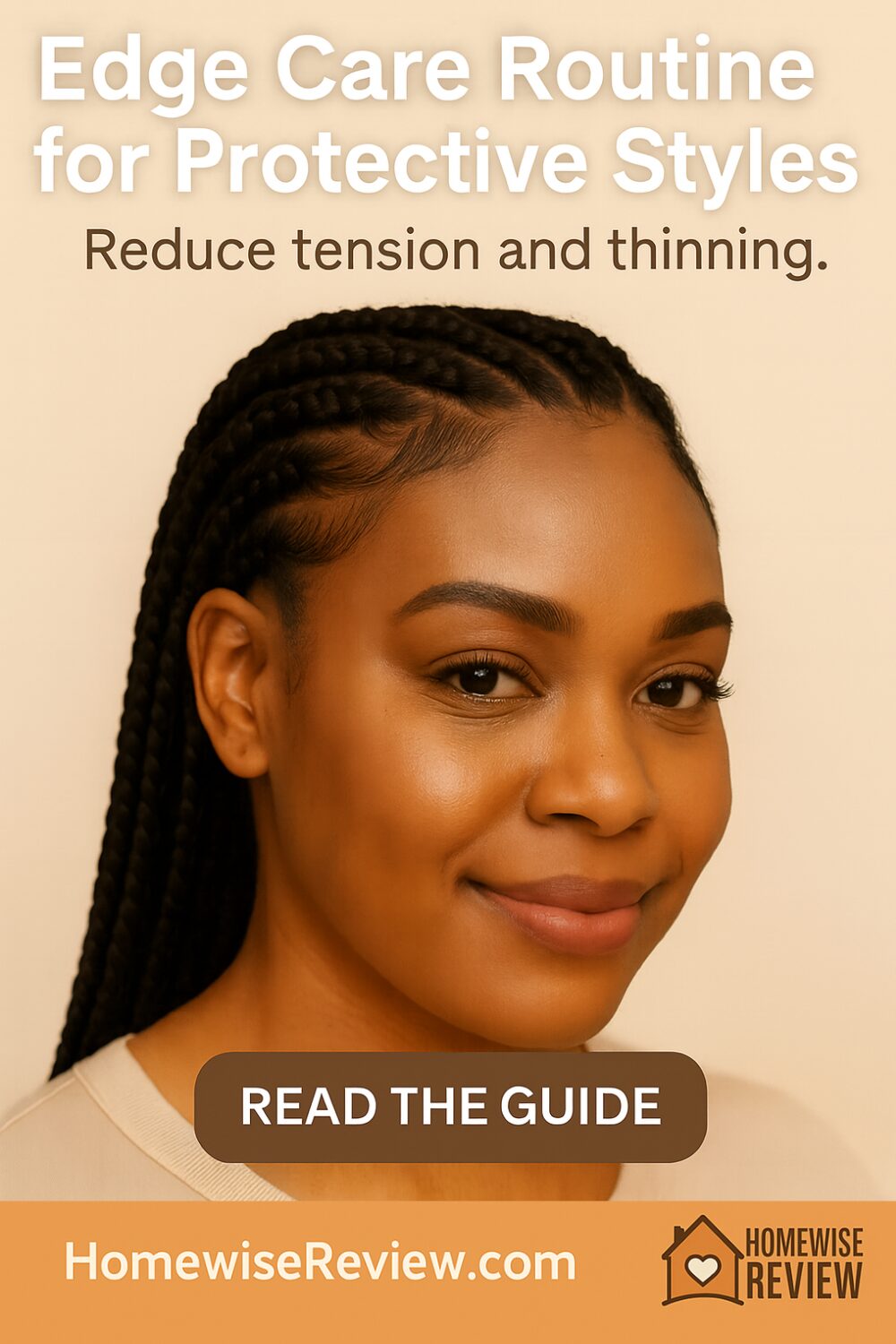
Who this is for: Anyone wearing braids, twists, sew-ins, wigs, or cornrows who wants neat edges without breakage.
Bottom line: Your edges need three things during protective styles. Lower tension at install, slip and moisture during wear, and a gentle take-down. Map your risk areas, ask for a tension check, keep product light near the hairline, and stick to a short schedule. Healthy edges are a style choice.
Know your edge risk map
- Thin spots and cowlicks: These areas lift first. Ask for larger parting or leave them out entirely.
- Temple corners: The shortest, most delicate hairs. Most owners do best with no added hair at the very front row.
- Nape: Friction from collars and sleep can rub this zone. Consider bigger parts or skip extensions here.
Two tests to run before install
- Slip test: On clean, dry hair, slide your fingers along the hairline. If it feels squeaky or rough, apply a light leave-in and a dab of oil to create glide so braiders are not fighting friction.
- Tug tolerance: Hold a small section at your temple and pull gently. If it aches right away, plan to leave that area out.
Prep the week before
- Clarify once, then follow with a rich deep conditioner for cushion.
- Light protein if edges feel wispy or styles collapse fast.
- Trim flyaway splits near the hairline so they do not tangle into knots during take-down.
- Stretch gently with a tension blow-dry on low heat and a real heat protectant. Stretched hair needs less pulling to grab.
At the salon: install choices that protect edges
- Ask for knot-less or feed-in techniques at the hairline. They anchor on your hair, not a bulky knot.
- Request larger parts on temples and nape, and skip baby hairs if they are fragile.
- Do a tension check. Turn your head, raise eyebrows, smile wide. If it pinches, ask for immediate loosening.
- Choose lighter hair or shorter lengths at the perimeter. Weight equals pull.
- Avoid tight edge braids that swoop backward. A clean, looser perimeter looks better by week two anyway.
Daily care while the style is in
Moisture without weight
- Mist the hairline every other day with a water-based leave-in. Press, do not rub.
- Seal with a pea of light oil or serum tapped along the edges only. Heavy grease lifts braids and gives buildup that breaks hairs on removal.
Neat edges without stress
- Use a soft, medium-hold edge control or gel sparingly. Smooth with a small brush, then tie down for 5 minutes with a satin scarf. The set holds better than piling on product.
- Rotate slick styles. Sleek bun today, looser tie-back tomorrow. Constant tension in one direction thins fast.
Sleep and friction
- Wear a satin scarf under your bonnet so edges are flat and protected.
- Swap cotton pillowcases for satin when the scarf inevitably slides off.
Wash and refresh schedule
Every 7 to 10 days
- Apply a nozzled scalp cleanser or diluted shampoo directly to parts.
- Gently squeeze water through. Avoid vigorous scrubbing at the hairline.
- Rinse well and press dry with a T-shirt.
- Mist leave-in along the perimeter and mid-lengths.
- Air dry or use a cool dryer to avoid mildew under extensions.
Itchy line fix
A few drops of scalp tonic with menthol or tea tree can soothe, but keep it light. Oils that flood the base soften anchors and cause slip and tug.
Edge-safe styling rules
- No micro edges. The first row should have larger parts or no added hair.
- No constant ponytails. Change the direction daily.
- No edge control on wet edges. Apply on dry skin and hair for less swelling and lift.
- No yanking flyaways. Use scissors to snip fuzz caught in bands instead of pulling.
Take-down without trauma
- 48 hours before removal: Start softening spray. A mix of water and conditioner helps unravel.
- Work in small sections. Snip extension hair far from your ends, then unwind.
- Oil the knot lightly if it sticks, wait one minute, then slide.
- After removal, detangle with slip before shampoo. Expect shed hair and be gentle.
- Follow with a wash, deep moisture mask, and then a light protein within a week if hair feels overly soft.
How long to keep a style
Most stylists recommend 4 to 6 weeks for braid or twist sets if you care about edges. Past that, new growth folds, anchors loosen, and friction climbs. Wigs on glueless bases can run longer, but keep adhesive off baby hairs and clean skin thoroughly between wears.
Red flags to stop and reset
- Persistent throbbing at temples after day two
- Pustules or scabs along the hairline
- White bulbs on snapped hairs at the edge of a braid
- Shiny skin where hair once was
Take the style down, switch to low-tension styles, and focus on recovery.
Recovery plan if thinning shows up
- Pause extensions for two cycles. Wear loose buns, twist outs, or a wig on a breathable, glueless cap.
- Moisture and light protein weekly for structure.
- Scalp massage with fingertip pads 3 to 5 minutes nightly using a thin serum.
- Document growth with monthly photos so you judge progress, not vibes.
Final Thoughts
Edges survive protective styles when you combine low-tension installation, feather-light daily care, and a calm take-down. Leave fragile hairs out, ask for knot-less techniques, moisturize with a mist not a flood, and tie down to set instead of over-gelling. Keep styles short and recovery steady. Healthy edges are the real protective style.
See Also
If edges already feel tender, start with Edge Control for Thinning Edges and Tension Areas for softer holds that set clean, then compare textures in Edge Control That Does Not Flake on 4C Hair so your slick days do not turn dusty by lunch. For sleep protection that actually helps, the Nighttime Routine for Natural Hair That Prevents Breakage guide shows scarf and bonnet combos that keep the hairline calm.
When it is time to reset buildup without stripping, use the timing chart inside Chelating vs Clarifying Shampoo: What Each Does and When to Use and then rebuild bounce with Protein Treatments for Breakage in Natural Hair. To build out your haircare kit see Best Natural Hair Products.
FAQs
How tight is too tight at install
If you feel pinching when you lift your brows or smile, it is too tight. Ask for loosening right then. Day-two throbbing is a sign to take the style down.
Can I use strong edge control daily
Use firm gels for events, not every day. For daily grooming pick medium hold, apply a tiny amount on dry edges, and tie down for five minutes.
How often should I wash protective styles
Every 7 to 10 days is a good rhythm. Clean the scalp and rinse well. Keep the hairline product light so removal is easier.
What is a safe wear time for braids if I care about edges
Four to six weeks. Past that, anchors loosen and friction at the hairline rises, which increases shedding and snap.
What is the safest way to remove braids at the hairline
Soften with water and conditioner, snip extension hair far from your ends, unwind slowly, oil any stuck knots lightly, then detangle with slip before shampoo.
Affiliate Disclosure
If you purchase through links on our site, we may earn a small commission at no extra cost to you.




